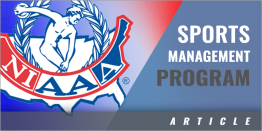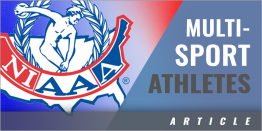|
The Transition Game: Assisting Students and Their Parents in the Shift from Middle School to High School Athletics One of the most challenging moments for any student progressing through their educational years is the experience of transitioning between the eighth and ninth grades. Youngsters who have grown into leadership roles in their middle or junior high schools are now suddenly thrust into an environment where they must "earn their stripes" all over again. In addition, they find themselves among upperclassmen whose levels of physical, mental, and emotional maturity are much different than theirs. For many first-year high school students, the freshman year is a virtual "no-man's land" where they must discover their self-identity and place in the school all over again. The transition from participation in middle school athletic programs to playing on high school teams can be equally difficult as well for both student-athletes and their parents. On one hand, many middle schools today espouse an athletic model that focuses on maximizing participation for all students and developing individual skills. A contrast to the competitive approach commonplace in high school athletic programs, this philosophy can create an atmosphere where students expect to play more and parents gain a false sense of their children's true abilities. By the same score, most high school sports programs require students to invest significant amounts of personal time, during both the regular campaign and the months in between seasons, to hone their athletic skills. High school seasons are generally longer in duration than those designated for middle school athletics. Furthermore, participation on a team may preclude a student from participating in a number of other school activities, such as community service organizations and fine arts groups. For many student-athletes, participation on a team is a six day per week commitment involving a myriad of activities beyond the game schedule, including practices, film review, travel to and from contests, fundraising, and team dinners. Although participation in athletics creates opportunities for learning how to balance one's time to include academics, family responsibilities, and personal wellness, many freshmen find the transition to playing high school sports a very stressful period. Through developing cultural practices employed at the team level and systematic activities designed to provide information and tools for both parents and students, today's high school athletic leaders can make a positive difference in the lives and experiences of their student-athletes. Although an athletic director cannot logically expect to fully remove the anxiety associated with a student's promotion from middle school to high school, he or she can certainly reduce that angst by (a) promoting a nurturing team environment on any squads that may employ ninth graders and (b) employing communication and educational strategies that assist people undergoing that change. Middle School vs. High School Athletic Philosophy: The "Stuff" of Change In order to help their ninth grade student-athletes make successful transitions to participating in high school athletics, it is critical for athletic administrators to fully understand the dynamics from which the initiates in their programs come. Although junior high schools functionally operated similar to high schools in the 1960's and 1970's, the shift to a middle school philosophy during the 1980's had profound changes on both educational curriculums and extra-curricular activities. The focus on the needs of the child, not mastering curriculum content, was one such profound change that impacted his or her educational experience. At the same time, the middle school movement promoted the concept that the sixth through eighth grade years should be a period of personal discovery in which students could explore a myriad of after school options in athletics, the arts, and community service activities. Middle school athletic programs in the 1980's were refitted to accomplish similar aims, and the importance of competition was minimized to address other objectives. Many middle school athletic leagues instituted playing time regulations to offer more students an opportunity to see the court or the field. At the same time, a number of middle school conferences dropped championship tournaments and meets from their schedules to de-emphasize the importance of winning. Schools offering multiple playing levels in a given sport incorporated seventh and eighth grade teams into their programs as opposed to "A" and "B" teams that replicated the high school model of varsity and junior varsity teams. Student-athletes and parents who have become accustomed to this model of athletic program may find the high school experience dramatically different, particularly if there is not an older brother or sister in the household who has not experienced this change. In addition to those issues identified earlier, other notable differences in this transition include:
Athletic administrators who are less familiar with the middle school philosophy are advised to become familiar with how those athletic programs are organized and administered in their area. In addition, the NIAAA offers two courses within the Leadership Training Institute (LTC 700, 701) that provide content about athletics at this level. Athletic directors are advised to participate in one or both of these four-hour courses in order to learn more about this topic. Managing the Transition High school athletic directors play a significant role in assisting student-athletes and their parents in managing the switch from participation in middle school to high school athletics. A number of strategies may be utilized to accomplish the overarching aims of ensuring proper communication and making the student-athlete's transition as seamless as possible. 1. Become a familiar face to the student-athletes and their parents One of the most effective strategies for helping middle school athletes and parents in this process is to make efforts to know them prior to their entry into the high school ranks. In many areas of the country, high school athletic directors play a dual role in which they have some or all responsibilities for their middle school or junior high school programs as well. Although many view this as an "add-on" component to their jobs, playing the dual role also creates a special opportunity to meet and become familiar with a wider network of people. High school athletic administrators are well advised to, whenever possible, attend middle school athletic events and watch their next generation of performers in action. Being a recognizable face to student-athletes and parents can pay large dividends in the long run. Part of the anxiety associated with the change from middle school to high school is not knowing or recognizing classroom teachers and administrators. Having been visible at middle school athletic events can create a vicarious sense of familiarity for students as well as demonstrate one's interest and commitment to the program. Similarly, given that many high school coaches offer summer camp opportunities to their up-and-coming athletes, the athletic director who checks in with the varsity coach during that time also provides an opportunity for students and their parents to see him or her. The sign-up process is also fertile ground for building relationships and developing familiarity as well. Athletic administrators should actively participate in "step-up days" in which eighth grade students tour the high school campus in the spring prior to their arrival. This avenue can be utilized to (a) introduce interested participants to high school coaches; (b) distribute all required participation forms; and (c) communicate general expectations and rules related to high school athletics. During this time, the athletic director should offer encouragement to those interested in participating in the high school program, even if they have not been involved in organized athletics as well. It may also be possible to use this opportunity to interact individually with students and introduce oneself as their high school athletic director. 2. Enhance the effectiveness of the annual parent information night Many athletic administrators host annual or seasonal information nights that offer opportunities for parents to meet the coaches involved in the athletic department. For the high school athletic director, the importance of these events when it comes to communicating policy and program philosophy cannot be understated. In particular, athletic administrators should incorporate the following components into their presentations:
In addition, the National Collegiate Athletic Association (NCAA) highly recommends that athletic directors communicate the initial eligibility guidelines for Divisions I, II, and III during these introductory meetings to ensure that students and parents build schedules that will meet those requirements. 3. Establish developmentally appropriate playing opportunities for freshman student-athletes One of the fourteen legal duties of athletic administrators is to appropriately match competition. Given the differences in physical maturity between seniors and first-year students, meeting this responsibility can be challenging. Athletic administrators can address this need in a number of ways:
Designing the athletic program so that younger players are not marginalized and have an opportunity to develop skills and experience success against their peers is perhaps the most effective way of easing the transition to high school athletics. When student-athletes are not discouraged at every turn, they are more likely to remain in the program. 4. Find avenues for parents to get involved in the athletic program As has been referenced earlier, a student's freshman year of high school is a transition year for his or her parents as well. Athletic administrators may help parents become more acclimated to the high school athletic program by encouraging them to become active participants in the program. Involvement in the parent boosters group will help parents gain instant access to information and develop a network of new friends. In addition, through their involvement in fundraising efforts such as concession or apparel sales, they can be of direct service and benefit to the program. Given that a student's stay in high school is only four years and that parent booster turnover is commonplace, most athletic booster organizations are constantly searching for new blood and the next generation of leaders. The parent information night and the athletic website are logical places to advertise the need for participation and to make the case for volunteering. In addition to serving as a member of the athletic booster organization, parents can become active in a number of other ways as well. High school athletic coaches may be able to offer other opportunities for parent involvement, including keeping the scorebook, tabulating game statistics, filming athletic contests, or hosting team dinners. Each of these opportunities provides avenues through which parents can become active members of a school's athletic community. ******************** The first year of high school is a stressful one for all individuals involved in a high school athletic program, including students, parents, and coaches. Athletic administrators who demonstrate direction in helping these individuals make that transition successfully provide a valuable service leadership function. Like all important initiatives, it starts with having objectives and a plan to achieve them. |







